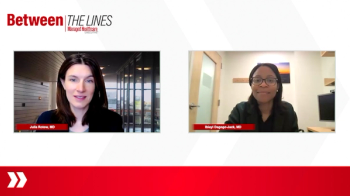
Predicting the Treatment Evolution of Hemophilia B
Steven Pipe, MD, describes his hopes for Hemophilia B treatment in the future.
Steven Pipe, MD: The current platform looks promising for durable correction in factor 9 levels that are sufficient to prevent most bleeding events and improve health-related quality of life, with a substantial elimination of the economic and personal treatment burden associated with factor 9 prophylaxis. However, with the eligibility limitations we've also indicated, the biggest one, for me, is that this is only for adults. By adulthood, a substantial portion of patients already have established joint disease. We would have a much bigger impact from gene therapy if we could do an earlier intervention in the pediatric age group. Unfortunately, with the way the AAV mechanism occurs by targeting the liver, the DNA—that's the transient—is delivered into the nucleus and remains episomal, which means it's primarily outside of the genome. When dividing liver cells, the transgene doesn't get propagated to the daughter cells. What that would mean is, if we did AV in a pediatric age group with a growing, dividing liver, the effect of the gene therapy will be deluded over time. We need different approaches for gene therapy to impact the pediatric age group.
Some of the things I've seen that show promise are non-viral approaches. By using a non-viral approach, you have the option to re-treat patients. That is not an option for patients who get current AV therapy because once you've delivered the AV once, the immunological consequences of that would preclude getting another AV dose sometime later. Right now, we're asking patients to make a once-in-a-lifetime treatment decision to receive gene therapy, but other approaches could also involve gene editing. When you do gene editing, you're either inserting the transgenes somewhere in the genome or modifying the factor 9 gene in such a way that you can restore factor 9 expression. Because you're editing directly in the genome, that would be propagated to daughter cells in a dividing liver. I'm already seeing some new protocols come to the forefront [that will be implemented] in the clinic soon. If these show their utility in adult patients, we'll see that these offered to younger and younger patients and, hopefully, the pediatric age groups where we can completely abrogate the development of joint disease.
The other thing I'm excited about is the evolving treatment landscape as applied to hemophilia B, not just invested in gene therapy approaches. There are several innovative treatment platforms that have been tested over the last few years. The ones I'm particularly excited about are non-factor placement therapies. These are cross-platform therapeutics that can work for hemophilia A or B regardless of whether the patient has had any prior inhibitor development to the factor 8 or factor 9 proteins. These primarily target the natural anticoagulants of the hemostatic process. They rebalance hemostasis without replacing the factor 9 molecule. Data that was presented at this most recent ISTH Congress [International Society of Thrombosis and Haemostasis] in July of this year showed encouraging results that can be applied to patients with hemophilia B. These are treatments that can be delivered subcutaneously. They have a lower intensity. Some of them are given either weekly, monthly, or once every other month—a low burden of treatment. They [provide] effective prophylaxis that, in some studies, is superior to traditional factor 9 replacement therapy. I'm excited about the evolving treatment landscape. Hemophilia B gene therapy [carries] great promise, but these other novel therapeutics are hopefully going to be available to us in the clinics quite soon.
Transcript edited for clarity.
Newsletter
Get the latest industry news, event updates, and more from Managed healthcare Executive.



















































